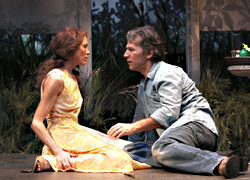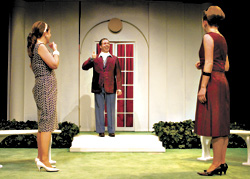Harper Lee’s novel To Kill a Mockingbird is an enduring staple of high-school English classes everywhere. So it’s an odd, roundabout sort of risk for Intiman to stage Christopher Sergel’s adaptation, a challenge to bring something new and fresh to a story with which most every reader is familiar. Doubly risky, perhaps, in that Gregory Peck’s turn as courageous lawyer Atticus Finch in Robert Mulligan’s 1962 film became one of popular culture’s truly iconic roles—one Peck seemed born to play, and which he owned. It’s good to report, then, that actor David Bishins does an admirable job as Finch, bringing to the part a hard-won wisdom and understated intensity. Bishins is surrounded by a strong ensemble cast; particularly noteworthy is the trio of young actors through whom this moral fable of bigotry, family, and justice in Depression-era Alabama is channeled. Scout (Keaton Whittaker), her brother Jem (Nick Robinson), and runaway Dill (Lino Marioni) take a far more central role in the play’s narrative than in the film, and they carry the story with grace and understanding. This, then, is the best news about the latest entry in Intiman’s American Cycle series.
Director Fracaswell Hyman, a veteran of children’s television, allows the story to unfold with all the ease, almost languor, of a summer’s day; he has a good feel for the rhythm and flow of small-town life, as well as for the more unsavory elements of gossip, prejudice, and mob justice. Hyman’s naturalistic approach gives Mockingbird an intimate atmosphere by turns close-knit and claustrophobic, and if at times his direction threatens to turn overly sentimental and nostalgic for the South’s fabled gentility and homeyness, he nonetheless allows this unique set of characters to breathe with all the idiosyncratic appeal of Lee’s creations. Alec Hammond’s set—an almost cartoonish but beautifully wrought portrait of Maycomb, Ala., in the ’30s, complete with rickety wooden houses and a big tree painted blood red—completes the haunting representation of small-town life gone completely off-kilter.
Beyond this, however, the play really doesn’t break any new ground nor add any surprising nuance or devilment to Mockingbird‘s story of racial injustice—it’s simply a well-known story told in a solid and safely straightforward manner. For many if not most theatergoers, this likely will prove more than adequate, though some may feel that the crew at Intiman has, ultimately, played it too safe.







